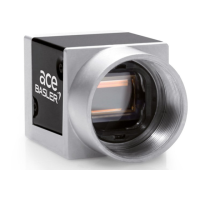AW00118508000 Features
Basler racer Camera Link 144
Default Startup Set
You can select the default configuration set or one of the user configuration sets stored in the
camera’s non-volatile memory to be the "default startup set." The configuration set that you
designate as the default startup set will be loaded into the active set whenever the camera starts
up at power on or after a reset. Instructions for selecting the default startup set appear in
Section 8.14.3 on page 146.
8.14.1 Saving Configuration Sets
Saving the current active set into a user set in the camera’s non-volatile memory is a three step
process:
Make changes to the camera’s settings until the camera is operating in a manner that you
would like to save.
Set the UserSetSelector parameter to UserSet1, UserSet2, or UserSet3.
Execute a UserSetSave command to save the active set to the selected user set.
Saving an active set to a user set in the camera’s non-volatile memory will overwrite any parameters
that were previously saved in that user set.
You can set the UserSetSelector parameter and execute the UserSetSave command from within
your application software by using the pylon API. The following code snippet illustrates using the
API to set the parameter and execute the command:
camera.UserSetSelector.SetValue(UserSetSelector_UserSet1);
camera.UserSetSave.Execute();
For detailed information about using the pylon API, refer to the Basler pylon Programmer’s Guide
and API Reference.
You can also use the Basler pylon Viewer application to easily set the parameters.
For more information about the pylon API and the pylon Viewer, see Section 3.1 on page 26.
1. Make changes to the camera’s settings until the camera is operating in a manner that you
would like to save.
2. Set the value of the User Set Selector register to User Set 1, 2, or 3 as desired.
3. Set the value of the User Set Save register to 1.
For more information about direct register access, see Section 3.2 on page 28.
To save the current active set to a user set in the camera’s non-volatile memory via direct
register access:

